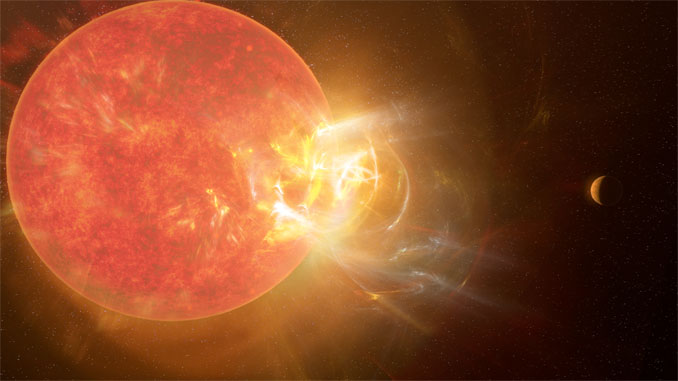
Astronomers monitoring Proxima Centauri, the nearest star to Earth’s solar system, have spotted the most powerful flare ever seen erupting from the red dwarf, a titanic outburst lasting just seven seconds that generated 100 times more power than any known flare from the Sun.
“Stars like Proxima Centauri look different from our sun, and they behave differently too,” said Parke Loyd, a postdoc at Arizona State University and a co-author of a recent paper in The Astrophysical Journal. “In particular, they flare a lot more than the sun, but we are only beginning to understand the magnitude and character of their flares.”
In a cooperative project, nine observatories monitored the M-class dwarf for 40 hours across several months in 2019, observing in multiple wavelengths to better understand the power and frequency of flares exploding from the surface of a star just four light years away.
Proxima Centauri hosts at least two planets, one of them possibly Earth like. The research campaign was focused on learning more about the physical mechanisms at work in such flares to get a better sense of how they might affect exoplanet habitability. Red dwarfs like Proxima Centauri are among the most common stars in the galaxy.
As luck would have it, the star erupted with a massive flare on 1 May 2019. Five of the nine observatories captured the event, including the Hubble Space Telescope, which detected an enormous pulse of ultraviolet light, and the Atacama Large Millimetre/submillimetre Array, which observed at radio wavelengths.
“The star went from normal to 14,000 times brighter when seen in ultraviolet wavelengths over the span of a few seconds,” said lead author Meredith MacGregor of the University of Colorado at Boulder. “We had never seen an M dwarf flare at millimetre wavelengths before 2018, so it was not known whether there was corresponding emission at other wavelengths.”
Such flares may not be unusual. The team noted many others during the 40 hours they observed Proxima Centauri.
“Proxima Centauri’s planets are getting hit by something like this not once in a century, but at least once a day if not several times a day,” MacGregor said. “If there was life on the planet nearest to Proxima Centauri, it would have to look very different than anything on Earth. A human being on this planet would have a bad time.”



